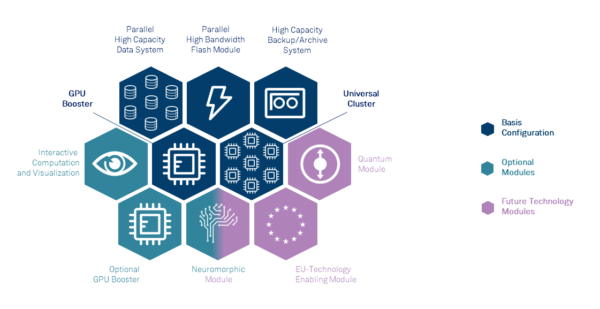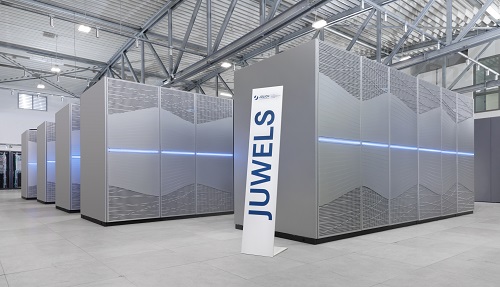Just a couple of weeks ago, EuroHPC Executive Director Anders Jensen told HPCwire that there would be big news coming out of the meeting of EuroHPC’s governing board in Kajaani, Finland yesterday. He wasn’t joking: today, the EuroHPC Joint Undertaking announced the first details of its first exascale system and also announced host sites and names for four additional petascale or pre-exascale EuroHPC systems. This represents the second major slate announcement from EuroHPC following the first slate of eight systems—now mostly complete—that was announced in mid-2019.
Meet JUPITER
JUPITER, EuroHPC says, will be the first European exascale supercomputer when it is installed in 2023. It will be hosted by the Jülich Supercomputing Centre (FZJ) in a specially designed building. JUPITER is a backronym for “Joint Undertaking Pioneer for Innovative and Transformative Exascale Research.”
FZJ says that JUPITER will be “based on a dynamic, modular supercomputing architecture,” sharing the below diagram illustrating the supercomputer’s basic form (dark blue) along with prospects for optional modules (teal) like a GPU booster module and future technology modules (pink) like a quantum module or a module based around EU-developed technologies. In its basic configuration, though, FZJ says that JUPITER will already have “an enormously powerful booster module with highly efficient GPU-based computation accelerators.”

FZJ likens this modular configuration to JUPITER’s predecessor, FZJ’s JUWELS system. First launched in 2018, JUWELS now contains a bevy of different configurations across its cluster and booster modules: compute nodes, large memory nodes, accelerated compute nodes, visualization nodes, GPU nodes and more. Until the twin launch of LUMI and Adastra a couple weeks ago, JUWELS’ booster module was the most powerful supercomputer in Europe, and it ranked 11th on the most recent Top500 list at 44.12 Linpack petaflops.

JUPITER is slated to cost a cool half-billion euros (~$521 million USD), with half of that coming from the EuroHPC Joint Undertaking, a quarter provided by the German Federal Ministry of Education and Research and the final quarter provided by the Ministry of Culture and Science of the State of North Rhine-Westphalia.
In its release, FZJ also paid attention to the enormous energy requirements of exascale supercomputers, saying that it expects JUPITER to require average power around 15 megawatts. (Compare to the 20.2 megawatts required by the 1.102 Linpack exaflops Frontier system, which works out to one exaflops in 18.33 megawatts.) Further, FZJ stressed that JUPITER will use warm water cooling and be “powered by green electricity”—and even hinted that, like the LUMI system in Finland, JUPITER’s waste heat might see productive use. (Recall Jensen’s emphasis on more holistic “energy stories” for EuroHPC supercomputers at ISC 2022.)
“The EuroHPC decision enables us to take this significant step towards exascale in cooperation with research and industry, scientific users and funding agencies,” commented Thomas Lippert, head of the Jülich Supercomputing Centre at FZJ. “Immense challenges exist at various levels – both technical and financial. However, it is important to realize that we are talking about a machine from which the whole of society will benefit. From traffic optimization, autonomous driving, and environmental monitoring right up to digital twins: all these challenges are extremely calculation-intensive and are reliant on new technologies, many of which we can tap into with the modular exascale system.”
No other system details about JUPITER have been revealed, but it will be interesting to see which vendors EuroHPC and FZJ select for Europe’s forthcoming flagship supercomputer amid a growing emphasis on sovereign European supercomputing.
… and the rest!
But that wasn’t all: EuroHPC also announced four additional sites for “mid-range supercomputers with petascale or pre-exascale capabilities”: Greece, Hungary, Ireland and Poland.
- DAEDALUS is the Greek system and will be hosted by the National Infrastructures for Research and Technology (GRNET).
- LEVENTE is the Hungarian system and will be hosted by the Governmental Agency for IT Development (KIFU).
- CASPIr is the Irish system and will be hosted by the National University of Ireland Galway (NUI Galway). In a press release, NUI Galway said that CASPIr is expected to be around 25 times more powerful than Ireland’s Kay system, which delivers 665 Linpack teraflops. (This works out to around 16 Linpack petaflops.)
- EHPCPL is the Polish system and will be hosted by the Academic Computer Centre CYFRONET AGH (CYFRONET).
All four of these countries are new additions to EuroHPC’s roster of host countries, joining Bulgaria, Czechia, Finland, Italy (announced), Luxembourg, Portugal (announced), Slovenia and Spain (announced).

EuroHPC plans to build at least two exascale systems in the next few years. No points for guessing where we think the second one will be hosted.



























































